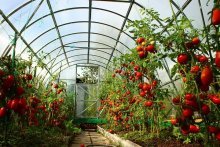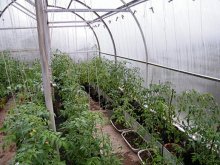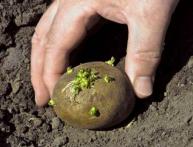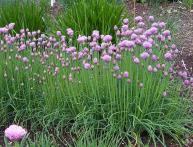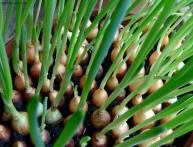Features of growing tomatoes in a polycarbonate greenhouse
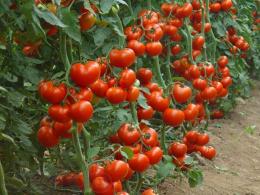
Growing tomatoes in a greenhouse and in open ground is significantly different. To reap a rich harvest, you need to choose the right tomato variety. It is important to know and follow all agrotechnical cultivation techniques tomato in a polycarbonate greenhouse.
Content:
- Tomato varieties for a polycarbonate greenhouse
- Pseed preparation and planting
- Rules for caring for tomatoes
Tomato varieties for a polycarbonate greenhouse
When choosing tomatoes for greenhouses, many factors should be taken into account: yield, fruiting period, size, disease resistance, tall or short variety. Mostly tall tomatoes are grown in polycarbonate greenhouses. They need to be constantly pinched and tied up. Indeterminate tomatoes grow up to the roof. Popular tall varieties for the greenhouse are:
- "Miracle of the Earth"
- "Khokhloma"
- "King of the Giants"
- "Octopus"
- "Pink Tsar"
- "Southern Tan"
- "Scarlet Mustang"
These varieties produce more yield and have a long fruiting period. From early varieties for greenhouses it is better to choose hybrids: Verlioka F1, Search F1, Druzhok F1, Typhoon F1, etc.
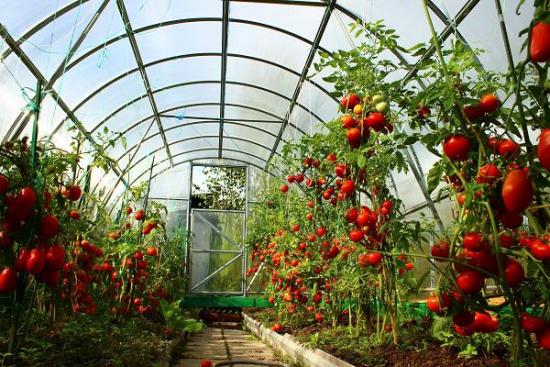
Many gardeners choose tomatoes by size. Of the large-fruited ones, “Cardinal”, “Eagle Heart”, “Mikado”, etc. are very popular. Medium-sized tomatoes can be obtained from varieties such as “Brilliant”, “Peter 1”, “Lamp”, “Kindergarten”, etc.The following varieties are suitable for preservation: “Sugar Plum”, “Cherry”, “Empire”, etc.
Seed preparation and planting
Seed material must be selected of high quality without signs of disease. Before sowing, the seeds need to be soaked for several days in a weak solution of potassium permanganate. The optimal time for planting seeds for seedlings is February-March. The soil for sowing and planting seeds must be the same. This way the plant adapts better to new conditions.
The first shoots need to be watered with warm water once a week. Subsequently, watering is carried out as needed. With the appearance of several leaves, the seedlings are transplanted. Seedlings are fed 2 weeks after transplants. A solution of nitrophoska is used as a fertilizer. When the height of the seedlings reaches 20-30 cm, they can be transplanted into a greenhouse. Fertile soil for growing tomatoes must be prepared in advance.
Video about growing tomatoes in a polycarbonate greenhouse:
It is necessary to remove the top layer, at least 10 cm thick, and disinfect the soil. To do this, dilute a tablespoon of copper sulfate with water in a 10-liter bucket and pour over the prepared solution. The soil mixture for tomatoes should consist of peat, sawdust and humus in a ratio of 2:1:1. A week before planting seedlings, it is imperative to treat the soil with phytosporin, trichodermin or other biological preparation.
This procedure will reduce the likelihood of developing fungal diseases. The seedlings are planted vertically in the prepared holes. The distance between plants should be enough so that the bushes do not shade each other. When planting low-growing varieties, it is necessary to maintain a checkerboard pattern and a distance of about 30 cm, since they form 2 shoots.
tall plants planted at a distance of 60-70 cm from each other. Lightly moisten the bottom of the hole, plant the plant and cover it with soil. In this case, it is necessary to ensure that the roots of the plant are completely covered. There is no need to water the bushes when planting. The first watering is carried out after 2 weeks.
Rules for caring for tomatoes
Caring for tomatoes consists of timely watering, high-quality fertilizing, tying, weeding and processing of plants. The plant is watered once a week until flowering begins. Watering should be moderate and only at the root. It is important to prevent the soil from becoming waterlogged, as this can lead to rotting of the fruit.
It is advisable to water in the evening. A few weeks after planting the seedlings, the bushes need to be tied up. It is also necessary to carry out pinching when the plant begins to gain green mass.
This procedure is carried out only in the morning. Side shoots should be removed regularly. Fertilizing should be done during the growing season. Fertilizer applied when the first ovaries form. You can use mullein solution, urea potassium nitrate, potassium monophosphate, etc. It is recommended to apply foliar feeding in the evening. Dew in the morning promotes better absorption.
To increase the number of ovaries, it is recommended to spray tomatoes with a solution of boric acid. When growing tomatoes indoors, it is necessary to observe the temperature regime. In the daytime, the optimal temperature is 20-28 degrees, and in the evening and night 15-16 degrees. Pollination of tomato flowers is carried out manually, since bees' access to the flowers is difficult. During pollination, you need to carefully shake the plant brushes, and then water and spray the bush with water.
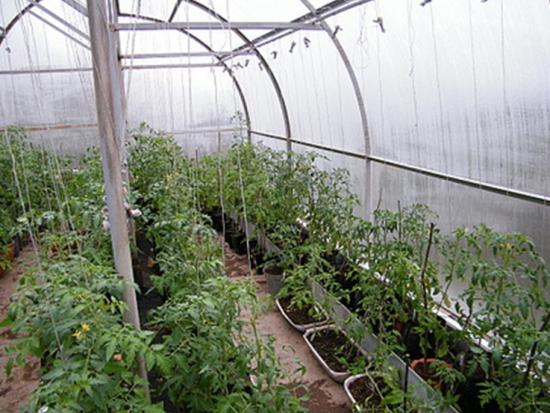
After this, it is necessary to ventilate the greenhouse to avoid waterlogging of the air and soil. Tomatoes should be ventilated regularly. You need to open not only the side windows, but also the top windows. Ventilation must be carried out during flowering of tomatoes. If a plant's flowers and fruits fall off, this indicates increased dryness of the air in the greenhouse. This problem can be eliminated by watering and ventilating the greenhouse.
To prevent the occurrence of pests and diseases, it is necessary to carry out agrotechnical measures to care for tomatoes in a timely manner. Tomatoes are most often subject to root rot, late blight, and blackleg. To combat possible diseases, it is necessary to disinfect the soil and spray the plants with fungicidal agents.
Good lighting, the required amount of moisture and heat, timely application of fertilizers and regular care - all this contributes to the early ripening of tomatoes. Subject to all care recommendations tomatoes you can grow a good harvest.

